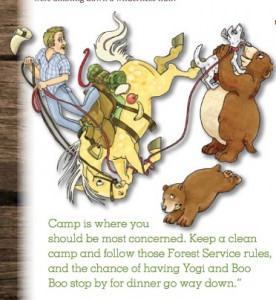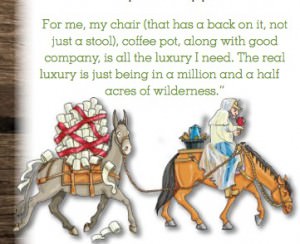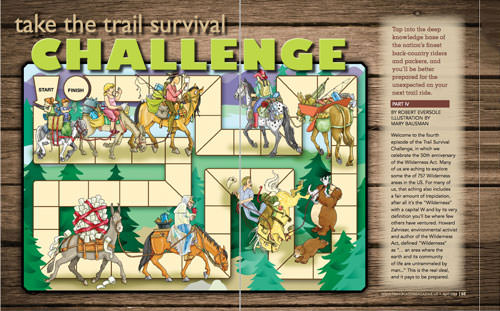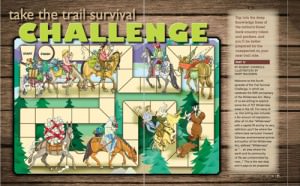Survival Series Episode IV – Wilderness Riding
2014 is the 50th anniversary of the Wilderness Act and many of us are aching to explore some the of 757 Wilderness areas in the U.S.A. For a lot of us that aching also includes a fair amount of trepidation, after all it’s the “Wilderness” with a capital W and by its very definition you’ll be where few others have ventured. Howard Zahniser author of the Wilderness Act defined “Wilderness” as “… an area where the earth and its community of life are untrammeled by man…” This is the real deal and it pays to be prepared.
Without further ado let’s introduce our experienced wilderness experts, each of whom brings a wide range of knowledge to this discussion, and who will be answering your questions and concerns about heading into a wilderness area with your horse.
Smoke Elser – With experience born from 53 years and over 8,000 nights in the back country, Mr. Elser has taught the skills of safe packing and camping in wilderness areas to game wardens, FBI agents, the U.S. Border Patrol, and even members of Navy SEAL teams. If you haven’t heard of “Smoke” from his book Packin’ in on Mules and Horses perhaps you saw him in the 2011 PBS documentary “3 Miles an Hour” which chronicles his passion and connection to the wilderness.
Ed Haefliger – Ed is a volunteer packer for the Olympic National Park and in addition to receiving the prestigious President’s Call to Service Award from President Obama for providing over 6,000 hours of pack support in the National Park he has also authored two seminal textbooks on the subject; The Packers Guidebook, and Trail Skills and More. These texts have not only helped scores of aspiring riders and packers but have also been used by the Brigham Young University and the Certified Horsemanship Association.
Andy Breland – Andy refers to the sprawling Bob Marshall Wilderness as his “Backyard” and for good reason, he’s spent more time there than most. Andy works closely with the Montana Department of Fish Wildlife and Parks; supporting them with packing expertise, as well as instructing their Becoming An Outdoors Woman (BOW) Horse Packing Workshops where he teaches groups of women the various aspects of packing including defensive horse handling; how to pack; and leave-no-trace camping. When he’s not deep within a wilderness area Andy can be found at Trailhead Supply, one of the best suppliers of horse packing gear and equipment.
TrailBLAZER readers sent in more questions, posers, and quandaries for this wilderness segment than I’ve seen in a while. Here are the four best!

I want to visit a wilderness area this year but I’m worried about what wildlife I’ll encounter. What should I do if I see a bear? Should I take my dog with me? Sincerely, Bearly There
This is a great topic even if Bearly There snuck in an extra question. A large part of the allure of the backcountry is the chance of seeing wildlife and to more than a few folks a large part of the perceived danger is encountering wildlife. As for dogs on the trail and in the backcountry; Roy Rogers had Bullet, and Big Jake had Dog so the idea is not without precedence. What would you do if you spotted a bear across the meadow as you were ambling down a wilderness trail?
- Call 911 on your cell phone and have the authorities deal with the bear.
- To heck with this “wilderness” stuff I’m turning around and heading back to civilization.
- Dismount and walk closer to the bear so your friends can take a great souvenir picture of you and the bruin.
- Stay alert and continue on your way while reveling in a magnificent sight that few others will ever experience.
Let’s hear what our three wilderness experts have to say on the topic.
SMOKE: I go to these areas to see the wildlife and to observe nature with cameras and binoculars. A chance to see a bear in its natural environment where we, the humans, are just visitors is a grand experience. Dogs in the backcountry add a large additional layer of responsibility because not only do you have yourselves and your stock to take care of you also have a dog that needs to be kept from harassing the animals that call the area home. Remember we, and the dog, are just visitors here.
ED: Well if your knickers wad up this easily I suggest door “B”. But “D” is the wisest for my money kind of choice. Wildlife is the true reason for the wilderness. One must remember that a bruin has a very large and long menu so the same conditions for dealing with radiation of any sort holds true here, called the time and distance factor: How long will I be in the proximity, with my critter, to this believed danger. In this case the distance sounds great and time is well on your side. We must add a plus worry item, because a bear is a living/breathing exposure that has its own attitude. And in this case it appears not to give a hoot, so roll along being alert, and have a great ride. Side bar note: as far as dogs in the backcountry……they are great cougar and wolf bait. As well as a pain for a pack string to deal with!
ANDY: Seeing a bear on the trail is a rare treat, enjoy this view, but not for long. Always be cautious and try to never get between mom and her cubs or you may totally understand the meaning of the phrase “Hell hath no fury like a woman scorned .” Camp is where you should be most concerned. Keep a clean camp and follow those Forest Service rules; and the chance of having Yogi and Boo Boo stop by for dinner go way down. The real danger on the trail is the old family pet. Your stock may be used to your dog, but the next string you pass doesn’t know your dog from Adam. Crossing paths with a hiker and his or her dog could be another issue as well. Controlling your dog from the saddle with all the sights and sounds could create a huge hazard for you and your stock. Leave Fido at home.
Now that we’ve heard from three gentlemen with more wilderness experience than 99.8% of the nation, I have a confession to make. Despite having spent more than a few days in the backcountry, I’ve never seen a bear, cougar, elk, or Sasquatch, while trail riding (In camp is another story). In fact I’m much more concerned about running into bees than I am about encountering larger dangerous wildlife. Most wildlife is far more concerned about us than we are of them and will quickly depart the area once they hear the hubbub of a group of horses and riders approaching. On topic of dogs in the wilderness, while I have taken my dog into the backcountry I advise against it. Not only can a loose dog harass the native wildlife a loose dog is in great danger itself from the far smarter critters that call the wilderness home. A leash will protect the dog from becoming lost, and also from porcupines, mountain lions, coyotes and other hazards. Unfortunately, a dog at the end of a leash poses a real challenge for horse riders. As I said I used to take my dog with me on backcountry trips, now Abby stays home where she’s much safer, although not especially pleased with the situation.
 Do I have to use an outfitter to camp in the wilderness? What are the benefits of using an outfitter? Yours, Out There.
Do I have to use an outfitter to camp in the wilderness? What are the benefits of using an outfitter? Yours, Out There.
Out There has, in my humble opinion, the best question of the month. There is so much that needs to be considered in a wilderness trip that using a guide or outfitter services can make the difference between a wonderful experience and an adventure of the not so fun variety. What are your thoughts about having someone help you get into a truly glorious location?
- Of course you need an outfitter, who else will groom and tack your mount for the day’s ride?
- Pay for an outfitter no way! Camping in the wilderness is the same as camping at a KOA.
- Maybe yes maybe no, it depends on what my goals are for the trip.
- I have to use an outfitter, their permits give them exclusive access to the wilderness.
Luckily for Out There we have an honest to goodness outfitter on this month’s panel. Smoke Elser started guiding and helping interpret the wilderness for people from around the world. Andy and Ed have helped more than a few people experience the outdoors as well. Let’s see what the three of them have to say about using an outfitter.
SMOKE: An outfitter has the experience, knows the trails and their conditions, and can help interpret the wilderness for you. If you’re not experienced it’s best to work with an outfitter not only for their knowledge but also for their stock’s knowledge of the trails. A good outfitter knows how his animals will react in a given situation, such as crossing that river, or cliff face, and also has the right equipment to get you there and back in a safe and enjoyable manner.
ED: Robert has been looking to long into his cigar smoke to ever consider a packer laying a brush on your stock after a long day operating as a “Bekins Moving Man” for your goodies and grub. “C” makes sense, because it opens the door for you to consider your own skills and personal resources. The wilderness camping experience can and maybe ought to be considered as not how much junk can I pack in to camp but how much do I really need! But if you minimize on your own camp, never minimize on your horse or mules needs. Always, recon enough information prior to a trip about the feed available for your gang and camp accordingly. Note: an outfitter can get you back in there for some preliminary tastes of back country camping without the cost to you for the keeping, rigging or training of your own stock. “Boy’o that was great” and you are bitten or “Oh my goodness never again”, enough said!
ANDY: Want a relaxing vacation? Then hire an outfitter. After a goodnights sleep, coffee is ready, breakfast is done, horses are fed and the outfitter knows where the fish are and what fly has been working to catch that big one. But you have been feeding your horses for years; and now it is the time to put them to work. Let’s see you’ll need a pickup load of new tack, camping gear, new tires on the horse trailer, fishing gear, certified hay, extra manties, a whole tackle box of lures and flies since you don’t know anything about fish, plenty of maps, all that good freeze dried food (since you don’t have enough stock to take in real food) and new ear plugs to muffle the sound of your wife’s voice either saying be careful or do you really know what you are doing? Ten days on your own in the back country with both the family and stock surviving…..Priceless!!!
Anytime we do something new it helps to be able to rely on the experience of someone who has been there before. That sage bit of advice works just as well for getting into the great outdoors as it does for learning to ride. Having a pro along will help you learn the best ways of doing things without you having to attend as many classes in the school of hard knocks. When I was first starting to venture into wilderness areas I had the great fortune to have several very experienced back country riders take me under their wings. Without having had the benefit of their experience I may well not be here today to relay the tales.
 I don’t have a pack mule can I still camp in a wilderness area? Truly Yours, Not Packin’.
I don’t have a pack mule can I still camp in a wilderness area? Truly Yours, Not Packin’.
Not Packin’ must not have read the April 2012 issue of TrailBLAZER where we talked about exactly this situation. Camping in a wilderness area is a very different experience than making brief day riding forays into these grand places. Camping in the wilderness lets us explore more remote areas deeper within a wilderness that may not be otherwise accessible. How would you go about staying overnight far from the trailhead?
- John Wayne didn’t have pack animals and he carried a 5 gallon coffee pot, I can too.
- I’ll hunt and fish for food and my horse can graze.
- I’m willing to break from tradition and use high tech alternatives.
- No hot shower? No way!
Since each of these gentlemen run strings of more pack animals than I can easily count on my fingers and toes I’m interested in hearing their take on light weight horse camping. Let’s see what the guys that have packed in everything from tents, to boats, to bridges have to say about the minimums required to safely camp in the wilderness.
SMOKE: A horse can carry 1/5 of his body weight at most and that includes not only tack but the rider as well. After you do the math how much weight to spare do you have for camping equipment and feed for your horse? Using pack stock enables you to go further into the wilderness, stay longer, and be more comfortable while you’re there.
ED: Live off of the land, dream on! Fish for every meal may sound cool from the couch but in the rain over that fire that will not quit smoking, the glint on the lily can fade away soon. Not to mention the legal issue of fishing or hunting seasons. History writes that “Mountain Men” were a lean lot from living off of the land and were also know to eat their horses and stew up their moccasins without a REI to pop in to for trail grub. So that’s a no go! “C” does it for me. High tech today is tomorrows traditional. High tech for the Native Americans was a trade wool blanket. They shed their leather garb as soon as they could trade fur for cloth. A helmet is wisely substituted for a traditional cowboy hat. The first time that cool looking oilskin duster leaks through and you are wet for the next 3 days’, modern water proof or breathable fabric starts to look pretty good. I have personally worked in oilskin rain gear and gladly traded it for modern waterproof fabric at first chance. Oilskin value to me is that it is really good at starting camp fires. The norm is that a traditional item or process is often replaced by evolution to a handier product or way.
ANDY: I applaud those who venture out with just a saddle horse. If the truth be known, the only reason I own so many animals is to pack in all of the items everyone has to bring along, that they never use, just so I can pack it back out again. All I pack in for myself is some food, a sleeping bag, fishing pole, and my coffee pot. Lord knows no one wants to meet me on the trail without my morning coffee. So why did I start pulling a string? So I could pack in a chair. It seems the ground has gotten a long way down there and stumps are not always conveniently located.
There’s always a minimum gear list whenever we’re dealing with horses and mules. Whether it’s the pocket knife and 1st Aid Kit that goes on every day ride to more the more involved loads that are required when overnighting. As a guy that doesn’t have a dedicated pack animal I’ve found that by paying close attention to each item’s weight and volume, I can safely and comfortably spend 1 to 2 nights in the back country without having to bring a pack animal along. For me the sites and experiences of a wilderness area more than make up for the absence of tents, hearty meals, and creature comforts that are often packed in. It may require subsisting on freeze dried hiker fare but my load for an overnighter is under ten pounds and sits below the cantle of my saddle.
 What is the one luxury item you take with you on every wilderness trip or what is the most memorable item you packed in? Best Regards, Wired.
What is the one luxury item you take with you on every wilderness trip or what is the most memorable item you packed in? Best Regards, Wired.
I like Wired’s question a lot. While the first rule of any type of camping, even with pack stock, is to leave the majority of stuff you were planning on taking at home. The truth is that most dedicated campers have some piece of “equipment” that accompanies them on every trip. For some of us these are functional items and for others not so much. Regardless these odd bits follow us into the backcountry on most every trip. What luxury items find their way into your camping supplies?
- A camp stove espresso maker solves the No Caffeine, No Camping problem.
- Portable speakers and an iPod for when the soft crackle of a camp fire just isn’t enough.
- Cots to keep you off the ground.
- Pure goose down pillows to snuggle into.
Let’s see what the experts say.
SMOKE: A luxury item that I take is a good tent or other shelter from the weather and a nowadays a good cot. I find that a cot makes for a better night’s sleep and makes putting my boots on in the morning much easier. Years ago I outfitted for a group for many years. Every year they would bring in a very valuable accordion. Now I often bring a battery powered keyboard to provide the evening’s musical entertainment.
ED: Robert that coffee is a must. Because I am limited for packer’s space when I am packing trail crews I am a bit of a minimalist. I have sustained myself at time on a day old subway sandwiches (hold the mayo please) and cold coffee in a spare canteen. Not a lot of fun but due able. I have sat in the rain in a slicker warming myself with a gas lantern while modern science heated my MRE (military, meals ready to eat.). Again not much fun but I was warm outside and later also warm inside. The next two items are both dual purposed items. First a wee stove. This can keep the coffee flowing and at the same time be used to give you safe drinking water, by boiling it. Second and most important is toilet paper. Never leave home without a more than adequate supply of this. Push the centers cardboard roil out and compress it into 2 plastic zip lock bags to keep it dry, wet T-paper is heart breaking. Now for its second use, if friends or folks you meet are out of it, you can use it for legal tender or high quality trade goods. I like your hat! Oh by the way! I have T-paper to trade!
ANDY: Luxury items vary from person to person. Every day I have folks coming into my store, Trailhead Supply, telling me about the trip they are going on or have just survived. A topic that is always discussed is what I wish I would have taken; or why did I ever take that!?! For me, my chair (that has a back on it, not just a stool), coffee pot, along with good company, is all the luxury I need. The real luxury is just being in a million and a half acres of wilderness. I have packed in a lot of odd size weird shaped rattley things. One day I was loading the pack stock at the trail head when a car pulled up a gal got out walked over and said, “Are you headed for Black Bear Cabin?” I said, “Yes I am.” She then said, “Can you take something in for me?” I said, “Sure” (never say sure till you see whatever it is) She then handed me a fresh huckleberry pie, still warm. Can you get this to the smoke jumpers there? I told her it may be more of a cobbler by the time I get it there but I would take it. My packing partner laughed at me and said “Just throw it away now, it will never make it.” I got it there and didn’t even crack the crust. I think about that pie on every trip, I pack everything as if it is that pie.
After hearing from these guys about their camp luxuries I’m a bit embarrassed to admit that I have a battered harmonica that calls the bottom of my saddle bags home. The bad part is that I can’t play it. Other than making critters large and small cringe, my lofty ideas of actually playing the blues harp have been for naught. And yet it stays in saddle bags. Maybe some day.
I know we try to keep these Survival Challenge features to 4 questions but I just couldn’t leave this one out.
My horse ground ties, I don’t need hobbles or a picket line, correct? Sincerely, Left Behind.
I and this month’s board of experts chatted about how fortunate it is to have a well behaved mount and that ground tying is a wonderful thing to teach our animals. We also agreed that regardless of how well a horse ground ties; if a highline isn’t included in his gear then Left Behind certainly will be.
With that we’d better wrap up this edition of The Trail Survival Challenge. Do you have a trail riding question that you’ve been aching to learn more about? Have you wondered if you did the right thing in a certain trail experience? Send us your questions and we’ll see what the best horsemen in the world have to say.



